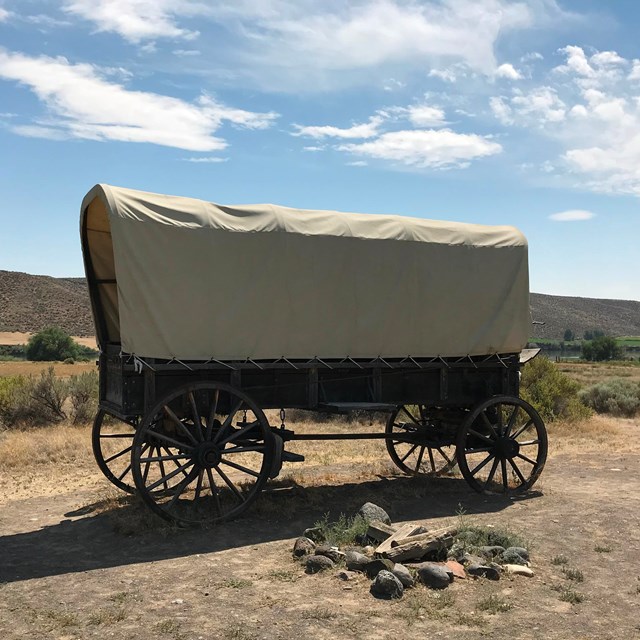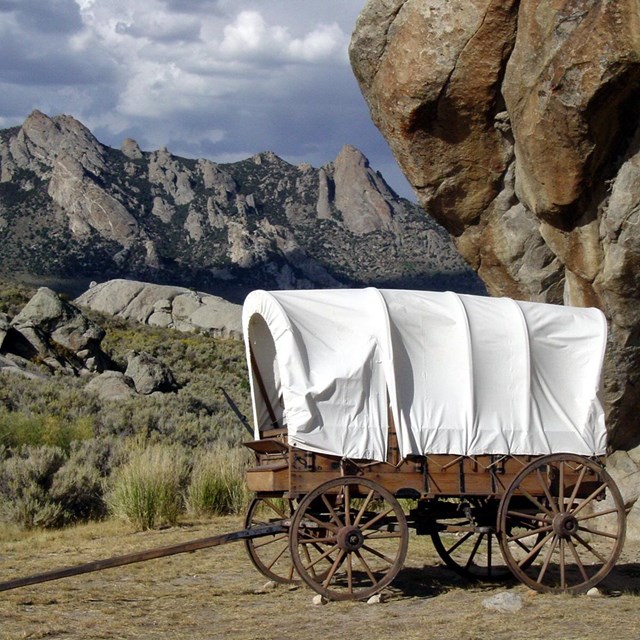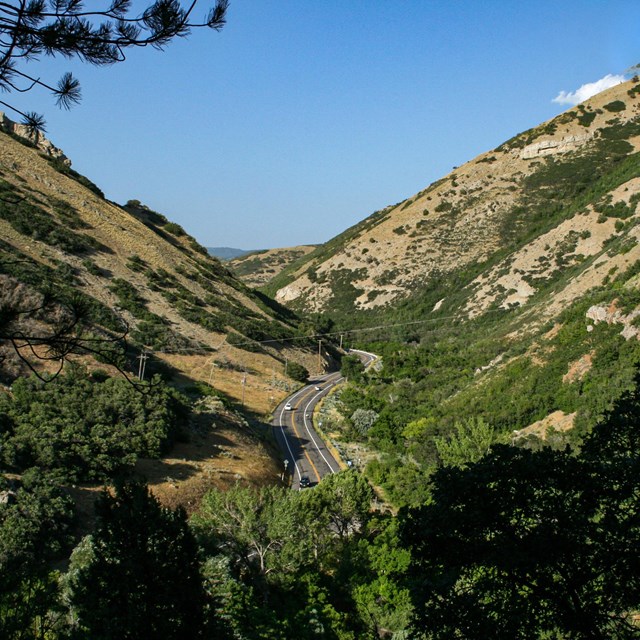Last updated: March 28, 2022
Article
Chapter 1: Race, Slavery, and Freedom - Utah: Slaves and Saints
Sweet Freedom's Plains
African Americans on the Overland Trails 1841-1869
By Shirley Ann Wilson Moore, PhD.
For the National Park Service
National Trails Regions 6, 7, & 8
Introduction/Table of Contents
Chapter 1 Sections
- The Early Black Presence
- The Question of Race
- The Evolution of Their Status
- The Contagion of Liberty
- Permanent, Hereditary Chattel: A Snapshot of Antebellum Slavery in the South, Indian Territory, and Border States
- Northern “Unfreedom”
- The Nature of Freedom in the West
- Utah: Slaves and Saints
- No Rights to be Respected
The treatment and status of African American emigrants to Mormon Utah were unique. They lived within a system that was unlike any other in the antebellum West. Historian D. Michael Quinn has written that Utah was the “only western territory where African-American slavery and slave-sales were protected by territorial statute.”74 Black overlanders who entered the Salt Lake Valley as part of the Mormon exodus to the West came both as free people and as slaves. Many of them were Mormon converts, but all of them were excluded by law and religious doctrine from full participation in society.
At least three slaves, Green Flake, Hark Lay, and Oscar Crosby (who were euphemistically called “servants” by their white Mormon owners), were part of the first contingent of 143 Latter-day Saints in 1847. Green Flake and Hark Lay had converted to Mormonism before they began the journey to Utah, and Oscar Crosby was baptized into the faith two weeks after arriving in July 1847. 75 They represented a fraction of the black men and women who settled in territorial Utah. Historian Newell G. Bringhurst has estimated that between 110 and 119 slaves and free black men and women were brought or freely emigrated to the Great Basin within the first four years of Mormon settlement. The years 1847 to 1850 marked the peak of black emigration to the region.76 At the close of 1847, 10 African Americans had arrived in the territory with other Mormon groups. By 1848, some 50 black people lived in the Salt Lake Valley among a general population of 1,700. The federal census of 1850 reported 24 free persons of color in Utah, and 26 slaves. The 1860 census counted 59 African Americans living in Utah Territory—30 free, and 29 slaves. Many, if not most, black arrivals were converts to Mormonism. However, race excluded them from equality. In Utah Territory (as in New Mexico Territory), the popular sovereignty clause of the Compromise of 1850 dictated the context for slavery. 77
The Mormon position on blacks and slavery was contradictory, but it ultimately reflected prevailing antebellum white racial attitudes and practices, despite the fact that many Mormon leaders (including Vermont-born Brigham Young) had come from regions where strong antislavery sentiment existed. In addition, Mormon doctrine condemned all forms of human bondage, and some Mormon leaders were vocal in their opposition to slavery. Mormon newspapers condemned the “slaveholder who deprives his fellow-beings of liberty,” and proclaimed that the institution of slavery had turned the United States into “an asylum for the oppressed.” Some accounts claim that in 1836 in Kirtland, Ohio, church founder Joseph Smith had personally ordained Elijah Abel, a former slave and Mormon convert, into the Mormon priesthood.78 In his 1844 campaign for the presidency, Smith’s published platform, Views of the Powers and Policy of the Government of the United States, denounced the peculiar institution, and called for the “break down [of] slavery” and the destruction of the “shackles from the poor black man.” His opposition to slavery did not advocate black equality, however; instead he proposed that the 3.2 million slaves be emancipated and then relocated to Texas, which was at that time part of Mexico, or to Canada.79
Mormon opposition to slavery reached a peak in the 1840s after the Latter-day Saints were expelled from Missouri and had established their new headquarters in Nauvoo, Illinois. However, as early as the 1830s, when anti-Mormonism was becoming more widespread and violent, Mormon leaders had begun to temper their religious opposition to slavery, hoping (in part) to avoid incurring persecution from anti-abolitionist forces. Therefore, in 1835, church membership approved an anti-abolition resolution that declared:
We believe it just to preach the gospel to the nations of the earth
and warn the righteous to save themselves from the corruption of
the world; but we do not believe it right to interfere with bond
servants, neither preach the gospel to nor baptize them, contrary to
the will and wish of their masters, nor to meddle with or influence
them in the least to be dissatisfied with their situations in this life
thereby jeopardizing the lives of men. Such interference we believe
to be unlawful and dangerous to the peace of every government
allowing human beings to be held in servitude.80
Thus, Mormons adopted the position of opposing slavery while rejecting its immediate abolition. When Brigham Young ascended to church leadership after Smith’s murder, his “attitude toward African-Americans differ[ed] from the founding prophet’s.”81 Young found justification in church doctrine for slavery and black subordination. In an 1852 speech before the Joint Session of the Legislative Assembly in Utah, he declared that church teachings held that blacks were descended from “Ham and Canaan” and were in league with Cain and the devil. Their lineage, therefore, condemned African Americans to be the “servant of servants.” In another speech, he proclaimed that the “seed of Canaan . . . will inevitably carry the curse which was placed upon them until the same authority, which placed it there, shall see proper to have it removed.”82
After Utah Territory was officially established as a result of the Compromise of 1850, Young, who claimed to own no slaves, nevertheless welcomed slaveholding Mormons into Utah. Speaking before territorial lawmakers in 1852, he made his position on the issue clear, declaring, “I am a firm believer in slavery.” He also maintained that if “a master has a Negro, and uses him well, he is much better off than if he was free.”83 He further observed that “the Negro in the Southern states are much better treated than the laboring classes of England.” In 1852, Young urged the legislature to adopt “An Act in Relation to Service” which legally recognized the enslavement of black people in the Great Basin.84 He saw the Act as a way to appease wealthy and politically connected Utah slave owners, to reach out to slaveholding Southern Mormons, to curry favor with proslavery representatives in Congress, and to limit the importation of slaves into Utah.85 The 1852 Act elaborated Mormon views of slavery, portraying black bondage not as chattel slavery but as indentured servitude. It cast Utah’s Mormon slaveholders in the role of benevolent masters who were urged to use their black servants with “all the heart and feelings, as they would use their own children.”86
The Act also laid out Utah’s slave code, which, unlike Southern slave codes, placed more emphasis on the regulation of slave owners than on their chattel property. Utah’s slave code prevented slave owners from selling their slaves out of the Territory without the consent of the slaves. It forbade slaveholders from engaging in “sexual intercourse with any of the African race” under penalty of fines ranging from $500 to $5,000. It required owners to furnish slaves with sufficient food, shelter, clothing, and recreational opportunities. It called for owners to provide schooling for slaves between the ages of “six and twenty years” for “not less than eighteen months.” In addition, the Act required Utah slaveholders to prove that their human property had come into the Territory “of their own free will and choice.”87
Despite its benevolent veneer, the Act was a culmination of anti-black sentiments that had begun to emerge before the Mormon pilgrimage to the Great Salt Lake Basin. In Nauvoo, Mormon leaders had begun to restrict African Americans’ political and civil rights by legally preventing them from voting, holding municipal office, marrying whites, and joining the militia. These racist trends intensified in the wake of Joseph Smith’s murder and western emigration.88 By early 1852, Utah blacks, enslaved and free, were banned by the territorial legislature (and by municipal officials in later Great Basin settlements) from voting, holding public office, and belonging to the territorial militia. These anti-black proscriptions were also written into the constitution of the proposed Mormon state of Deseret in 1856, 1860, and 1862.89
Next Section - Chapter 1, Race Slavery Freedom: No Rights to be Respected
74 D. Michael Quinn, The Mormon Hierarchy: Origins of Power (Salt Lake City: Signature Books, 1994), 659; Ronald G. Coleman, “Blacks in Utah History: An Unknown Legacy,” Utah History to Go, an online project, http://historytogo.utah.gov/people/ethnic_cultures/the_peoples_of_utah/blacksinutahhistory [accessed January 2, 2011]; Coleman, “A History of Blacks in Utah, 1825-1910,” 32-36.
75 Taylor, In Search of the Racial Frontier, 71; Jack Beller, “Negro Slaves in Utah,” Utah Historical Quarterly 2 (October 1929): 122-123; Dennis L. Lythgoe, “Negro Slavery in Utah,” Utah Historical Quarterly 39 (Winter 1977): 41-42; William E. Parrish, “The Mississippi Saints,” The Historian 50, no. 4 (August 1988): 492; Coleman, “Blacks in Utah History.”
76 Newell G. Bringhurst, Saints, Slaves and Blacks: The Changing Place of Black People Within Mormonism (Westport, Conn.: Greenwood Publishing, 1981), 218, and especially Table 9, “Number of Blacks (Slave and Free) Who Apparently Migrated to Utah during the Period 1847-1850,” 224.
77 For black population in Utah, see Taylor, In Search of the Racial Frontier, 72; U.S. Bureau of the Census, “Historical Census Statistics on Population Totals by Race, 1790 to 1990, and By Hispanic Origin, 1970 to 1990, For the United States, Regions, Divisions, and States,” Table 59, Utah –Race and Hispanic Origin: 1850 to 1990, online project of the Population Division, U.S. Bureau of the Census, Washington, D.C., Working Paper Series, No. 56, September 2002, http://www.census.gov/population/wwwdocumentation/twps0056/twps0056.html [accessed May 19, 2011]; U.S. Bureau of the Census, Seventh Census of the United States, 1850 (Washington, D.C.: Government Printing Office), 993. See also 1860 Census; and Coleman, “Blacks in Utah History.” For a discussion of Mormon persecution, anti-Mormon violence, and general nineteenth-century perceptions of Mormons, see Will Bagley, So Rugged and Mountainous: Blazing the Trails to Oregon and California, 1812-1848 (Norman: University of Oklahoma Press, 2010), 291-293, 370-372; Quinn, The Mormon Hierarchy: Origins of Power, 82-141, and The Mormon Hierarchy: Extensions of Power (Salt Lake City: Signature Books, 1997), 241-261. For the Mormon position on African Americans and slavery, see Newell G. Bringhurst, “The Mormons and Slavery: A Closer Look,” Pacific Historical Review 50, no. 3 (August, 1981): 337-338; Bringhurst, Saints, Slaves and Blacks; Quinn, The Mormon Hierarchy: Extension of Power, 286-287; Lester E. Bush, Jr., “Mormonism’s Negro Doctrine: An Historical Overview,” Dialogue 8 (1973): 11-68; Ronald G. Coleman, “‘Is There No Blessing for Me?’: Jane Elizabeth Manning James, a Mormon African American Woman,” Taylor and Moore, African American Women Confront the West, 144-162; James B. Christensen, “Negro Slavery in the Utah Territory” 18 (Third Quarter 1957): 298-305, especially 299 for black population; and Nathaniel R. Ricks, “A Peculiar Place for the Peculiar Institution: Slavery and Sovereignty in Early Territorial Utah,” (master’s thesis, Brigham Young University, 2007), especially 18-49, 99-124.
78 Nauvoo Neighbor, September 10, 1845, and Latter Day Saints Millennial Star (published in Liverpool, England), September 1843, both quoted in Bringhurst, “The Mormons and Slavery,” 332; Bringhurst, Saints, Slaves, and Blacks, 37-39; Newell Bringhurst, “‘The Missouri Thesis’ Revisited: Early Mormonism, Slavery, and the Status of Black People,” in Black and Mormon, ed. Newell G. Bringhurst and Darron T. Smith (Urbana: University of Illinois Press: 2006), 13-33; Margaret Blair Young, “Abel, Elijah (1810-1884),” The Black Past: An Online Reference Guide to African American History, BlackPast.org, http://www.blackpast.org/?q=aaw/abel-elijah-1810-1884 [accessed July 7, 2011].
79 Joseph Smith, Jr., General Smith’s Views on the Government and Policies of the United States (Nauvoo: John Taylor, 1844), online at the Joseph Smith Home Page, The Church of Jesus Christ of Latter-Day Saints, from the L. Tom Perry Special Collections at Brigham Young University, http://contentdm.lib.byu.edu/cdm4/document.php?CISOROOT=/NCMP1820-1846&CISOPTR=2836 [accessed May 10, 2011]. See also Bringhurst, “The Mormons and Slavery,” 3, 332; Quinn, The Mormon Hierarchy: Origins of Power, 119; Timothy L. Wood: “The Prophet and the Presidency: Mormonism and Politics in Joseph Smith’s 1844 Presidential Campaign,” Journal of the Illinois State Historical Society 93, no. 2 (Summer 2000): 167-193, especially 180-182; and Bush, “Mormonism’s Negro Doctrine,” especially 13-22.
80 The text was originally published in the Latter Day Saints Messenger and Advocate, August 1835; Timothy L. Wood: “The Prophet and the Presidency,” 180-181; Bringhurst, “The Mormons and Slavery,” 331.
81 Quinn, The Mormon Hierarchy: Origins of Power, 286-287, quote on 659.
82 For Young’s position on slavery and the inferior position of blacks, see “Speech by Governor Young in Joint Session of the Legislature, giving counsel on a Bill in relation to African Slavery, given at Salt Lake City on Friday, January 23rd, 1852, (Reported by George D. Watt; BPP, HDC),” in The Teachings of President Brigham Young, vol. 3, 1852-1854, ed. Fred C. Collier (Salt Lake City: Collier’s Publishing Company, 1987), 26, 27 (hereafter cited as Collier, "Governor Young's Speech, January 23rd, 1852”); Collier, The Teachings of President Brigham Young, “Governor Young’s Speech, February 5th, 1852,” (hereafter cited as Collier, "Governor Young's Speech, February 5th, 1852”); Collier, “Governor Young’s Speech , February 5th, 1852) 44, 45; “The Message of Governor Brigham Young, delivered to the Council, and House of Representatives of the Legislature of Utah Territory, at Salt Lake City, on Monday, January 5th, 1852, (Reported and prepared for delivery by Thomas Bullock and Thomas W. Ellerbeck; DN, vol. 2:18-#5, 1/10/52),” 16. See also Brigham Young interview by Horace Greeley, July 13, 1859, reprinted in The Salt Lake Tribune, August 15, 1993, http://www.utlm.org/onlineresources/sermons_talks_interviews/brighamgreeleyinterview_july131859.htm [accessed May 12, 2011]; Bush, “Mormonism’s Negro Doctrine,” 22-27; and Bringhurst, “Mormons and Slavery,” 336.
83 For accounts of the creation of Utah, see Bagley, So Rugged and Mountainous, 370-372, and Quinn, Mormon Hierarchy: Extensions of Power, 236-240. Young was virulently anti-black. Citing theological reasons, Young opposed intermarriage between blacks and whites even within the Mormon faith, but condoned intermarriage between Mormon men and Indian women. For example, when informed that a black Mormon man had married a white Mormon woman in Boston, Young stated that he would have both of them killed “if they were far away from the Gentiles,” instead of in Boston. By contrast, Young urged Mormon elders to marry Indian women as part of God’s plan to make Indians “a White and delightsome people” and to “learn them the [Mormon] gospel.” Young’s statement about the marriage of a black Mormon man and a white Mormon woman is quoted in Quinn, The Mormon Hierarchy: Origins of Power, 478. For Young’s comment about Mormon elders and Indian women intermarrying, see Scott G. Kenney, ed., Wilford Woodruff’s Journal, vol. 3 (Midvale, Utah: Signature Books, 1983), 241, as quoted in David L. Bigler and Will Bagley, The Mormon Rebellion: America’s First Civil War, 1857- 1858 (Norman: University of Oklahoma Press, 2011), 29. For the quotes regarding Young’s support of slavery, see Collier, “Governor Young’s Speech, January 23rd, 1852,” 26-28. 84 “Collier, “Governor Young’s Speech, February 5th, 1852,” 218.
85 For a succinct summary of the Act see Taylor, In Search of the Racial Frontier,” 73-74. For a more detailed account of the Act, see Bringhurst, “Mormons and Slavery,” 332-338.
86 For Young’s views on slavery, see Collier, “Governor Young’s Speech, February 5, 1852,” 45. See also Bringhurst, “Mormons and Slavery,” 336, and Dennis L. Lythgoe, “Negro Slavery in Utah,” Utah Historical Quarterly, 39 (Winter 1971): 52.
87 Original quotes from “An Act in Relation to Service,” in Acts, Resolutions, and Memorials of the Legislative Assembly of the Territory of Utah (Salt Lake City, 1855), 160-162, quoted in Bringhurst, “Mormons and Slavery,” 335. See also Taylor, In Search of the Racial Frontier, 73-74.
88 Bringhurst, “Mormons and Slavery,” 336-337.
89 Taylor, In Search of the Racial Frontier,” 73; Bringhurst, “Mormons and Slavery,” 337; Lythgoe, “Negro Slavery in Utah,” 51-54; Ricks, “A Peculiar Place for the Peculiar Institution,” 121-130; Coleman, “Blacks in Utah History.”




